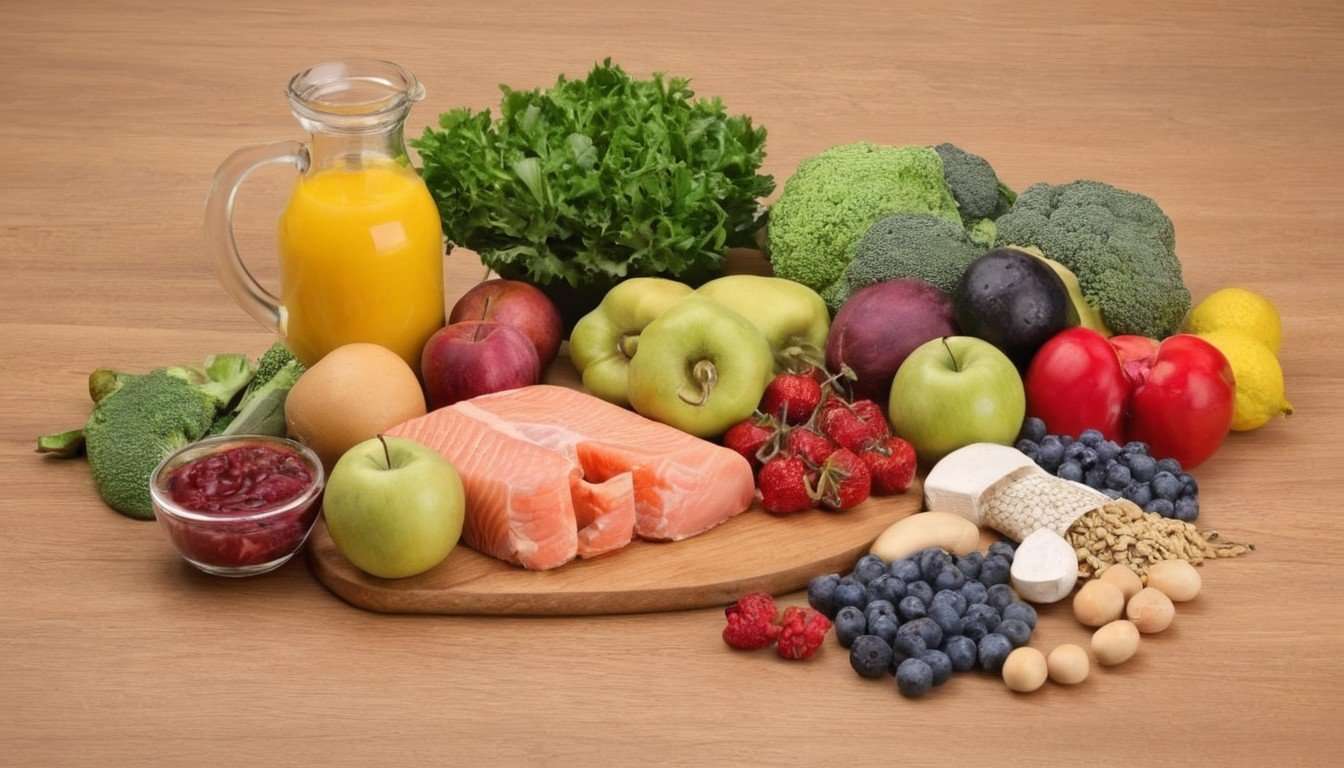Did you know that high triglyceride levels affect nearly one-third of American adults? If you’re among those looking to take control of your health, this 7-day diet plan could be the key. By making simple yet impactful changes to what you eat, you can work towards reducing your triglyceride levels and improving your overall well-being.
This blog post will guide you through a week-long journey filled with delicious and nutritious foods that can help lower your triglycerides naturally.
Get ready to revamp your eating habits and discover how small tweaks in your diet can lead to significant health benefits. Say goodbye to unhealthy levels and hello to a healthier lifestyle with this practical 7-day diet plan designed specifically for lowering triglycerides.
Understanding Triglycerides and Their Impact on Health
Importance of a Healthy Diet
A 7-day diet to lower triglycerides can significantly impact heart health by reducing the risk of heart disease. Consuming foods low in saturated fats, trans fats, and sugars while incorporating nutrient-dense options like fruits, vegetables, whole grains, and lean proteins can help manage triglyceride levels effectively. For instance, replacing red meat with fatty fish rich in omega-3 fatty acids, such as salmon or mackerel, can be beneficial.
Eating meals that are balanced in terms of nutrients is crucial for maintaining overall health and managing triglyceride levels. Avoiding sugary beverages like soda and opting for water or herbal tea instead can make a notable difference. Limiting processed foods with unhealthy fats and sugars is essential for improving heart health.
Meal Planning Tips
When planning a 7-day diet to lower triglycerides, it’s important to consider portion sizes to control calorie intake effectively. Including plenty of fiber-rich foods like oats, beans, lentils, and fruits helps regulate blood sugar levels and reduce triglycerides. For example:
-
Start the day with a breakfast consisting of oatmeal topped with fresh berries.
-
Incorporate snacks such as almonds or carrots with hummus between meals.
-
Opt for grilled chicken breast paired with quinoa and steamed vegetables for dinner.
Cooking methods also play a significant role; choose baking, grilling, and steaming over frying to minimize added fats in meals. Reading food labels carefully to identify hidden sources of saturated fats or sugars is crucial when selecting products from the grocery store.
The Role of Diet in Managing Triglyceride Levels
Impact of Triglycerides on Heart Health
Eating a healthy diet is vital in managing blood triglyceride levels and reducing the risk of heart disease. High levels of triglycerides are linked to an increased risk of heart problems, making it essential to focus on dietary choices.
Foods high in sugar, saturated fats, and refined carbohydrates can raise triglyceride levels, while foods rich in omega-3 fatty acids, fiber, and antioxidants can help lower them. By adopting a balanced diet focused on whole foods like fruits, vegetables, whole grains, lean proteins, and healthy fats like those found in nuts and seeds can effectively reduce cholesterol levels.
Maintaining a 7-day diet plan specifically designed to lower triglyceride levels involves incorporating foods supporting heart health while avoiding those contributing to elevated triglycerides. For example:
-
Including fatty fish such as salmon or mackerel rich in omega-3 fatty acids.
-
Opting for whole grains like quinoa or brown rice instead of refined grains.
-
Choosing healthy fats from sources like avocados or olive oil over saturated fats from processed foods.
Benefits of Following a 7-Day Diet Plan
A structured meal plan focusing on lowering triglyceride levels over seven days provides numerous benefits beyond just improving heart health. It offers individuals guidance on what to eat daily to support overall well-being by consistently promoting healthier food choices throughout the week. Additionally:
-
Planning meals ahead helps individuals make better decisions.
-
Increased intake of nutrient-dense foods boosts energy levels and supports weight management goals.
Key Components of a Triglyceride-Lowering Diet
Limit Sugars
Consuming excessive sugars can elevate triglyceride levels. Opt for natural sugars found in fruits over added sugars in processed foods. Avoid sugary beverages like soda and sweetened teas, as they can spike triglycerides.
Cutting down on sweets, pastries, and candies is crucial to managing triglycerides effectively. Replace sugary snacks with healthier options like nuts or Greek yogurt to help maintain stable triglyceride levels.
Reduce Trans Fats
Trans fats are known to increase bad cholesterol (LDL) while lowering good cholesterol (HDL), leading to higher triglycerides. Check food labels for hydrogenated oils as they contain trans fats that can raise your risk of heart disease.
Avoid fried foods and commercially baked goods which often contain trans fats. Opt for cooking with olive oil or avocado oil instead of vegetable shortening or margarine to reduce trans fat intake effectively.
Choose Low-Cholesterol Foods
Foods high in cholesterol may contribute to elevated triglyceride levels. Focus on incorporating lean proteins like chicken, fish, and legumes into your meals while limiting red meat consumption.
Include plenty of fruits, vegetables, whole grains, and nuts in your diet as they are low in cholesterol but rich in essential nutrients that support heart health. Experiment with plant-based protein sources such as tofu or lentils for variety.
Emphasize Good Cholesterol
Boosting good cholesterol (HDL) helps lower triglycerides by aiding the removal of excess fats from the bloodstream. Engage in regular physical activity such as brisk walking or cycling to improve HDL levels naturally.
Incorporate healthy fats like avocados, fatty fish rich in omega-3s like salmon or mackerel into your diet to promote good cholesterol production. Snack on almonds or walnuts, which are packed with monounsaturated fats that are beneficial for heart health.
The Ultimate 7-Day Diet to Lower Triglycerides
The 7-day diet plan to lower triglycerides emphasizes consuming foods low in saturated fats, trans fats, and sugars, while incorporating nutrient-dense options such as fruits, vegetables, whole grains, and lean proteins.
Day 1: Kickstarting Your Journey
Dietary Changes
Making dietary changes is crucial for lowering triglycerides and improving heart health. By following a 7-day diet plan tailored to reduce triglyceride levels, you can kickstart your journey towards better cardiovascular wellness. A healthy diet is an effective way to manage and lower triglycerides in the body.
A diet rich in fruits, vegetables, whole grains, lean proteins, and healthy fats can significantly impact your triglyceride levels. For example:
-
Consuming foods high in omega-3 fatty acids like salmon or chia seeds can help lower triglycerides.
-
Opting for whole grains over refined grains provides more fiber, which aids in reducing triglyceride levels.
Benefits of Dietary Changes
Implementing dietary changes not only helps lower triglycerides, but it also enhances overall health. Some benefits include:
-
Improved heart health by reducing the risk of cardiovascular diseases.
-
Weight management as a result of consuming nutrient-dense foods that keep you full longer.
Taking small steps each day toward healthier eating habits can have significant long-term effects on your well-being. It’s essential to focus on making sustainable changes rather than quick fixes when aiming to improve your lipid profile.
Day 2: Incorporating Omega-3s and Fiber
Adding Omega-3s
Omega-3 fatty acids are essential for heart health. Salmon, tuna, and eggs are rich sources of omega-3s. Including these in your diet can help lower triglyceride levels. Eating salmon twice a week or incorporating a boiled egg into your breakfast are simple ways to boost your omega-3 intake.
Consuming fish like tuna not only provides omega-3 but also offers lean protein, which is beneficial for overall health. Consider preparing grilled salmon with a side of steamed vegetables for dinner to create a balanced meal that supports heart health by reducing triglycerides.
Increasing Fiber Intake
Fiber plays a crucial role in managing triglyceride levels. Foods high in dietary fiber, like whole grains, fruits, and vegetables, can help regulate blood sugar levels and reduce the absorption of dietary cholesterol. Opting for fiber-rich foods such as oatmeal for breakfast or having vegetable soup as an afternoon snack can aid in lowering triglycerides.
Incorporating more lentils, beans, and legumes into your meals is an excellent way to increase fiber intake while promoting heart health. These foods not only provide fiber but also offer plant-based proteins that contribute to better cardiovascular function.
Day 3: Focusing on Whole Grains and Lean Protein
Importance of Whole Grains
Whole grains are a crucial component in a diet aimed at lowering triglycerides. Carbohydrates from whole grains like brown rice, quinoa, and wheat pasta can help regulate blood sugar levels. These foods provide sustained energy throughout the day, preventing spikes that can impact triglyceride levels negatively.
Including whole grains in your meals, such as having a turkey sandwich on whole grain bread or opting for a salad with quinoa instead of refined carbohydrates like white bread, can positively influence your triglyceride levels. By making these simple swaps, you’re managing your diet and supporting overall heart health.
Lean Proteins for Triglyceride Management
Lean proteins play a significant role in reducing triglycerides. Foods like skinless chicken breast, tofu, fish rich in omega-3 fatty acids, and legumes are excellent choices to incorporate into your meals. These proteins are low in unhealthy fats compared to processed meats or high-fat cuts of beef.
When planning your meals during this 7-day journey to lower triglycerides, consider grilling some salmon for dinner or preparing a stir-fry with tofu and vegetables instead of opting for fried options high in trans fats. Making these adjustments not only benefits your blood lipid profile but also supports better heart health overall.
Day 4: Adding Antioxidant-Rich Foods
Benefits of Antioxidant-Rich Foods
Antioxidant-rich foods are essential in a 7-day diet to lower triglycerides. These foods help reduce inflammation and oxidative stress in the body, contributing to heart health. Fruits like berries, such as strawberries and blueberries, are packed with antioxidants that can benefit your heart.
Adding avocado to your meals provides monounsaturated fats and antioxidants that support heart function. Tomatoes contain lycopene, an antioxidant known for its heart-protective properties. Incorporating these foods into your diet can enhance overall cardiovascular health.
Including Nuts in Your Diet
Nuts are another excellent addition to your daily meals when focusing on lowering triglyceride levels over seven days. Walnuts, almonds, and pistachios are good choices due to their high content of healthy fats and antioxidants. These nuts also provide fiber which aids in reducing cholesterol levels.
Incorporating nuts into salads or having them as a snack can be a simple way to boost your antioxidant intake while keeping you full between meals. However, it’s important not to consume large portions as they are calorie-dense foods.
Day 5: Emphasizing Plant-Based Fats
Choosing Healthy Fats
Opting for healthy fats is crucial. Instead of saturated fats found in animal products, focus on incorporating unsaturated fats from plant-based sources like olive oil and avocados. These healthier fats can help improve your lipid profile.
Eating fatty fish rich in omega-3 fatty acids is also beneficial for lowering triglyceride levels. Consider adding salmon, mackerel, or trout to your meals as they are excellent sources of these heart-healthy nutrients. By choosing the right types of fats, you can positively impact your cardiovascular health.
Cutting Out Sugary Drinks
To further reduce added sugars and support your efforts in managing triglycerides, replace sugary beverages with healthier alternatives. Opt for water as your primary drink throughout the day to stay hydrated without consuming unnecessary calories or sugar. Herbal tea is another great option that not only hydrates but also provides additional health benefits.
Infused water is a tasty way to add flavor without the need for added sugars. You can create delicious combinations by adding fruits like berries or citrus slices along with herbs like mint or basil. This refreshing alternative helps you steer clear of the empty calories present in sodas and sweetened drinks.
Day 6: Balancing Macronutrients and Hydration
Importance of Macronutrients
Balancing macronutrients is crucial for a healthy diet. It involves consuming the right proportions of carbohydrates, proteins, and fats. Carbohydrates provide energy, while proteins aid in tissue repair and growth. Fats are essential for hormone production and nutrient absorption. When planning your 7-day diet to lower triglycerides, ensure each meal contains a good balance of these macronutrients.
Eating whole grains like brown rice or quinoa can help regulate blood sugar levels due to their high fiber content. Lean protein sources such as chicken breast or tofu can keep you full longer, reducing unhealthy snacking habits. Incorporating healthy fats from sources like avocados or nuts can improve heart health by lowering bad cholesterol levels.
Importance of Hydration
Staying hydrated is key to supporting various bodily functions, including digestion and circulation. Water helps flush out toxins from the body and aids in maintaining optimal organ function. During your 7-day diet to lower triglycerides, it’s vital to drink an adequate amount of water throughout the day.
Hydrating with herbal teas or infused water can add flavor without extra calories or sugars that may negatively impact your triglyceride levels. Avoid sugary beverages like soda or fruit juices as they can spike blood sugar levels, leading to increased triglycerides.
Day 7: Planning for Long-Term Success
Increase Fiber Intake
To maintain healthy triglyceride levels, it’s essential to focus on a sustainable dietary plan. Increasing fiber intake by incorporating fruits, vegetables, and whole grains into your meals can significantly benefit your heart health. Fiber works wonders in lowering triglycerides and promoting overall well-being.
Consuming foods rich in omega-3s is another crucial aspect of managing triglycerides effectively. These healthy fats are found in fatty fish like salmon, mackerel, and sardines. By including omega-3s in your diet alongside fiber-rich foods, you create a powerful combination that aids in reducing triglyceride levels.
Long-Term Health Benefits
Planning for long-term success involves making lifestyle changes that support not just immediate results but also sustained well-being. Research studies have shown the positive impact of a diet high in fiber and omega-3s on heart health. By following a balanced eating plan rich in these nutrients, you not only lower your risk of cardiovascular issues but also enhance your overall quality of life.
Here’s a quick breakdown of the benefits:
-
Lowered Triglyceride Levels: A diet abundant in fiber and omega-3s has been proven to reduce triglycerides significantly.
-
Heart Health Promotion: These nutrients not only target triglycerides but also support overall heart function.
-
Sustained Wellbeing: Incorporating these elements into your daily meals ensures long-lasting health benefits.
Final Remarks
You’ve learned how to tackle those pesky triglyceride levels through a strategic diet plan. Remember, it’s not just about what you eat but how you approach it. Stay committed to these changes, and your body will thank you. Small steps lead to big victories, so keep at it!
Now, armed with knowledge and a plan, it’s time to take charge of your health. Start implementing these dietary adjustments today and watch as your triglyceride levels fall. Your journey to better health begins now. Keep pushing forward, and remember, you’ve got this!
Frequently Asked Questions
What are triglycerides and why is it important to manage their levels?
Triglycerides are fats in your blood that provide energy. High levels can increase the risk of heart disease. Managing them through diet helps maintain a healthy heart and overall well-being.
Can I follow this 7-day diet plan if I have dietary restrictions like gluten intolerance or lactose intolerance?
Yes, this diet plan offers flexibility to accommodate various dietary restrictions. You can make substitutions or adjustments based on your specific needs while still focusing on lowering triglycerides effectively.
Is exercise recommended along with this 7-day diet for lowering triglycerides?
Absolutely! Exercise complements a healthy diet in managing triglyceride levels. Physical activity helps improve lipid profiles and overall cardiovascular health. Incorporate regular exercise into your routine for better results alongside following the dietary recommendations.
How soon can I expect to see improvements in my triglyceride levels by following this 7-day diet plan?
Individual responses may vary, but many people notice positive changes within a few weeks of adopting healthier eating habits. Consistency is key, so stick to the plan beyond the initial 7 days for long-term benefits in managing your triglyceride levels.
Are there any specific foods that should be completely avoided while following this 7-day diet to lower triglycerides?
While the focus is on incorporating beneficial foods, it’s advisable to limit intake of sugary treats, processed foods high in trans fats, and excessive alcohol consumption as they can elevate triglyceride levels. Emphasize whole, nutrient-dense foods for optimal results during the 7-day period and beyond.





